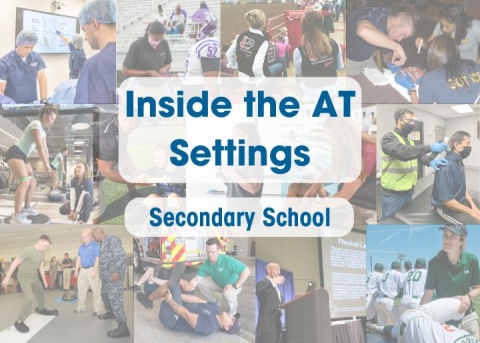
Introduced in the April NATA News, this NATA Now article series provides insight into the different athletic training settings as well as information athletic training students and interested ATs need to know. The series also provides tips from members on how to succeed in each setting.
Jennifer Rheeling, MS, LAT, ATC, athletic trainer at KIPP DC College Preparatory High School, has been in the secondary school setting for 33 years. Rheeling said she was enamored by the AT profession, following in the footsteps of a high school classmate’s older sister, Robyn Thompson Etzel, ATC. Along with both hard and soft skills she developed in undergraduate school, Rheeling’s graduate school experience firmly rooted her in the secondary school setting.
“I loved school and had many amazing examples of fostering healthy development in students and never considered any other setting,” she said.
Keep reading as Rheeling provides insight into the secondary school setting.
Typical Makeup of Your Population
I have spent the entirety of my career – 32 years – in one school system, in urban schools that are virtually entirely African American (99%) and are largely low-income. I’m in my first year with another school system with similar demographics. I feel my role as their athletic trainer is to serve as an extension of public health and school services, an advocate for quality, equitable health care and a surrogate parent when they are under my care.
Non-AT-Related Skills/Education/Certification Required or Helpful for Your Setting
In the secondary school setting, I believe soft skills are essential: communication, conflict resolution, time management, setting boundaries, self-confidence and understanding your role as a patient advocate. We’re often an island and have to protect our shores from erosion!
Common Injuries Observed or Encountered in Your Setting
The day-to-day injuries are strains and sprains and overuse conditions, especially those affecting the lower extremity. Concussions are pretty common. The schools I have been at haven’t had aggressive throwing teams, so shoulder and elbow pathologies have been minimal.
Traits of a Successful AT in Your Setting
Strong work ethic and sense of responsibility, patience, steadiness, willingness to learn and grow, affinity for interacting with adolescents and an understanding of their development stages, good time management and ability to pivot, ability to set boundaries, confidence in their skills, ability to make quick decisions under pressure and act accordingly, being detail-oriented and organized, empathy/compassion, a collaborative mindset and knowing you can’t and don’t have to do everything yourself.
Misconceptions About Your Setting and/or Patient Population
No secondary school athletic trainer has avoided the question, “Don’t you want to move up to the collegiate/professional setting?” This is my destination and the professional preparation of athletic trainers across settings is the same. Each of us has our own strengths and personalities, but an AT is an AT!
Also that we are all underpaid and overworked. Many of those positions still exist, but many positions have aggressive salary and benefit packages with great work-life boundaries. The one I was fortunate to have for 32 years didn’t start that way. Collectively, we advocated hard to improve our positions. I’m very proud of that, and that those positions informed the development of the position I currently hold. I’m grateful for the experiences and resources I have gained from NATA that have helped me with my advocacy efforts.





